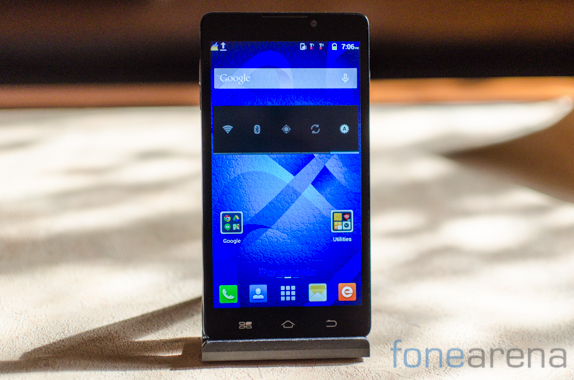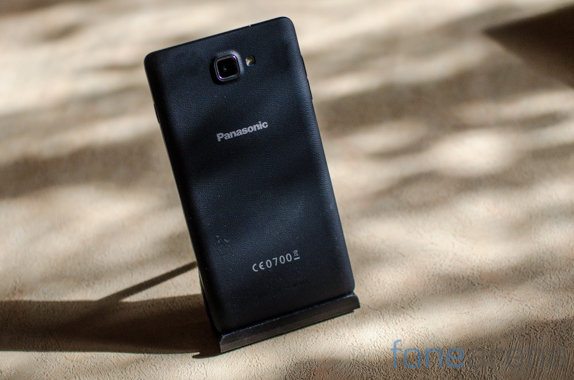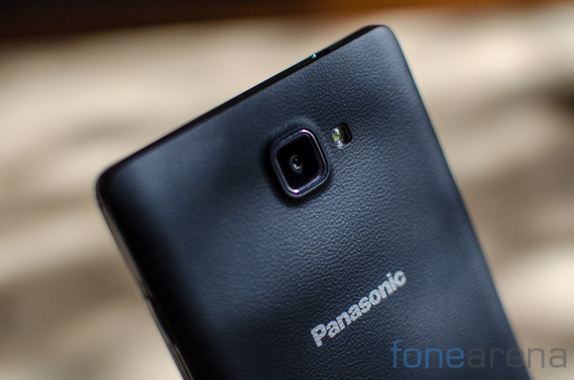With its new octa core offering, Panasonic is trying to break into the upper mid range category dominated by the likes of Micromax and Karbonn. The unique selling point here is the presence of an octa core chipset and the promise of superior construction. The internals are fairly consistent with most of the competition including the Micromax Knight.
Panasonic P81 specifications
- 5.5-inch (1280 x 720 pixels) HD IPS display
- 1.7 GHz Octa-Core MediaTek MT6592 processor with Mali450-MP4 GPU
- Dual SIM with dual standby
- Android 4.2 (Jelly Bean)
- 13MP rear camera with LED Flash, 1080p video recording
- 2MP front-facing camera
- 3.5mm audio jack, FM Radio
- 1GB RAM, 8GB internal memory, expandable memory up to 32GB with MicroSD
- 3G HSPA+, WiFi 802.11 b/g/n, Bluetooth 3.0, GPS
- 2500 mAh battery
Video Review
httpv://www.youtube.com/watch?v=ya-8sET_VRI
Hardware
At first glance, the Panasonic P81 looks like a part of the crowd. The phone remains a large black slab with the now mostly redundant capacitive buttons below the screen. Above the display lies the front facing camera.
Call it a focus on minimalism but even with run of the mill front fascia, we found the Panasonic P81 to be a perfectly appealing device. The 5.5 inch display when switched off melds seamlessly into the slim, inky black bezels.
With a 5.5 inch display, there’s only that much that you can do to improve ergonomics. Following the lead of the LG G2, Panasonic has managed to keep bezels slim that means that the phone can just about be held without stretching your hand too much. Add to that the slim 7.9mm profile and you get a phone that will easily slip into any pocket.
A metal trim runs along the sides of the phone. This is marred by the power key located on the right hand side while the left side includes the volume rocker. The volume control keys lie flush with the side of the phone which means that it isn’t exactly to press them. The 3.5mm audio jack is located at the top of the phone while the microUSB port is placed at the bottom of the device.
The back of the phone is where the hardware gets a bit interesting. Taking cues from the Samsung Galaxy series, the phone sports a faux leather back. While it doesn’t feel quite as luxurious as the material on the Galaxy S5, it also lacks the perforations seen on the S5’s back. The black leather like material in fact feels rather nice to hold and provides a very good grip. Branding is kept fairly minimal with just the Panasonic logo over at the back. Above this lies the 13MP camera module that unfortunately protrudes out from the shell. Flanking it to the right is the single LED flash.
Overall the hardware while run of the mill, doesn’t disappoint either. The phone manages to look mildly interesting because of the clean design language, the faux leather back feels good. Panasonic has also done a good job with the ergonomics of the phone by keeping the bezels slim.
Software
The Panasonic P81 runs on Android 4.2.2 and as such is well behind the curve. From the moment you switch on the phone, certain customizations are very evident. Gesture Play is the default means of unlocking your device. The ability to make certain gestures on the screen to launch specific applications is cool but quickly becomes a nuisance if you want a quick glance at your screen.

Nevertheless, the implementation is solid and we rarely had to re-enter the gesture. You can chose from a range of other unlock methods including the standard slide to unlock, facial recognition based unlock, voice, pattern, pin and password based unlock. This goes beyond what is offered by most smartphones. Here is a demo video that shows how these gestures work.
httpv://www.youtube.com/watch?v=VTn_Zf6HPAY

The main interface is lightly skinned. The user experience comes close to stock but not quite the same. Panasonic has skinned the icons but not touched much else. A wide range of (mostly) useful applications come preloaded on the device. This includes the Quick Dial app, Readwhere, Play More, Pop-i Player and our favorite Power Saver application.

The Powersaver application built into the Panasonic P81 is one of the most impressive and feature packed implementations we’ve seen so far. It offers the average user a lot of granular control over state based battery control. With certain tweaks, we were able to get standby times well ahead of the competition. We’ll talk more about this in the battery section below. Overall, the Panasonic P81’s software is minimally tweaked and is generally optimized well enough to not be an issue.
Performance
The Panasonic P81 is powered by a 1.7 GHz Octa-Core MediaTek MT6592 processor with Mali450-MP4 GPU. This is part of the lower bin of MediaTek’s Octacore chipsets. The processor is usually up to scratch to power the handset. We’ve done an in depth story on what powers the MT6592 processor. Instead of creating clusters or having both A7 and A15 cores for heterogenous multi processing, what you get is a grid of eight efficient Cortex A7 processors in its octa core configuration. Each of these cores can go right up to 2.0 Ghz but have been clocked at 1.7Ghz. With properly optimized applications, the benefits of having additional cores can outweigh the outward performance boosts gained by having A15 cores.
Where the phone does feel a bit underspecced is in terms of RAM. With just 1GB on board, we couldn’t help but feel that the phone ran out of steam all too often because of shortage of RAM. At its price point and market positioning, the Panasonic P81 should definitely have shipped with 2GB of RAM onboard. Performance in day to day usage is good enough for the most part with the occasional stutters or lags. We put the handset through a range of synthetic benchmarks to get an idea of how it compares with other handsets in the price range.
Quadrant
The Panasonic P81 scores 14282 points in the Quadrant benchmark which is amongst the highest in its category but it trails the Micromax Canvas Knight A350 that scores 15613 points.
Nenamark 2
The phone achieved 59 frames per second in the NenaMark 2 benchmark. This is a GPU centric benchmark that gauges the graphic rendering performance of a handset.
AnTuTu
The AnTuTu 4.0 benchmark gives a cumulative performance score across various aspects of the device including the GPU. The Panasonic P81 scored 26965 points here. Overall synthetic benchmarks only tell part of the story when testing performance of a device. We were mostly satisfied with the fluidity of the interface and speed of opening applications on a day to day basis. This isn’t to say that it was perfect as the phone did show occasional lags and would heat up a fair bit while playing graphically intensive games. Check out the gaming review below.
httpv://www.youtube.com/watch?v=fPqDwMgUdnU
Display
The phone has been equipped with a 5.5 inch 720p panel. This brings pixel density to about 267.02 which is far from the highest around. We’d have preferred to see a 1080p panel here given the large size of the screen but the trade off would have been a higher price point. It is understandable why Panasonic went with a lower resolution panel given the price sensitive segment it is targeting. The display is an IPS panel and performs like you’d expect.
Outdoor visibility is good but not great as brightness levels could have been a bit higher. For indoor usage, we found the panel to be fantastic as far as viewing angles are considered. Colors were oversaturated but this comes down to individual preference. A lot of users might actually prefer the boosted colors for multimedia consumption. While on paper the pixel density wasn’t particularly high, there was little to complain about in day to day usage. Sure, the 720p panel does display some jaggies around icons if you go looking for it but it really is not a dealbreaker.
Camera
The camera on the Panasonic P81 is a 13MP unit capable of autofocus. The phone can record full HD video as you’d expect. Over at the front is a 2MP camera module.
Over to the side of the camera module is a single LED flash for low light shots. During our testing, the phone had a tough time throttling down the LED flash which resulted in ghost like, washed out images. We would refrain from using it.
Image quality in general is quite good. The camera is great at taking close up shots and as most other phones in the category, takes more than passable shots in good lighting conditions. The camera did struggle with dynamic range and using the HDR mode helped in those situations. In less than ideal conditions, the shadow regions had a tendency to meld together resulting in blurry greens. Noise levels also went up. We can’t really recommend the camera if you plan to shoot a lot of low light shots but for all other situations, it’ll work just fine.
httpv://www.youtube.com/watch?v=95aoY8guj1A
Connectivity & Battery Life
The Panasonic P81 comes with all the standard connectivity options. This includes 3G HSPA+, WiFi 802.11 b/g/n, Bluetooth 3.0 and GPS. The phone is of the Dual SIM variety with only SIM 1 supporting both WCDMA and GSM. SIM 2 on the other hand supports only GSM connectivity. The phone has 8GB of built in storage and you will definitely need to use microSD card slot for expansion.
A 2,500 mAh user replaceable battery pack can be found under the rear panel of the phone. Our battery benchmarks estimated 6 hours of screen on time with a 70% CPU work load, constant data activity and screen brightness set to 60%. This should emulate an average work load. If you are gaming on your device, expect the screen on time to drop down further. For average daily use we could easily get over a day of usage time on the phone and have enough juice left over to get through half of the next day. You can further stretch this by using the rather capable power saver application.
Conclusion
We quite liked the Panasonic P81. It offers a sensible balance between design, specifications and price point. The design while nothing extraordinary, looks good enough and the slim bezels, faux leather improves ergonomics. The phone feels great when held in the hand. Performance too is fine for the most part.
There were times when we wished that the phone shipped with 2GB of RAM to avoid the intermittent lags. 16GB of storage is also a must in a phone in this category. Additionally, the camera was somewhat lacking when the lighting conditions got tough. The Panasonic P81 is a good phone but lacks a bit too much to be a great one in our opinion. Prospective buyers should also consider other devices in the category including Intex’s Octa Core handset which offers double the storage and RAM at a similar price point.
Pros
- Ergonomics
- Battery Life
- Software Optimization
Cons
- Limited Storage, RAM
- Screen brightness levels
- Low light image quality



















